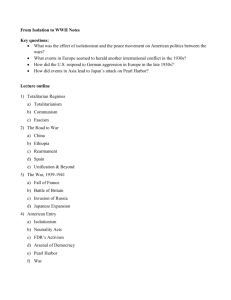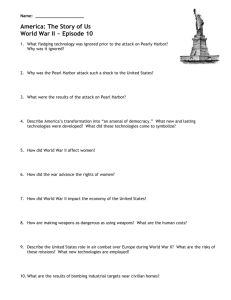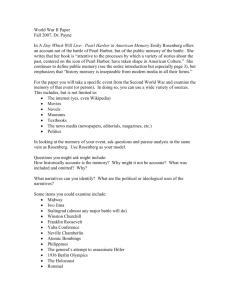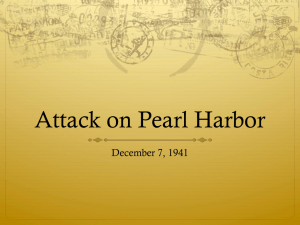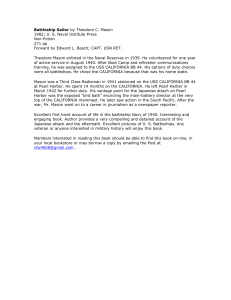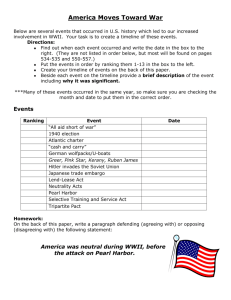Native Americans, Hawaiians and Dec.7, 1941
advertisement
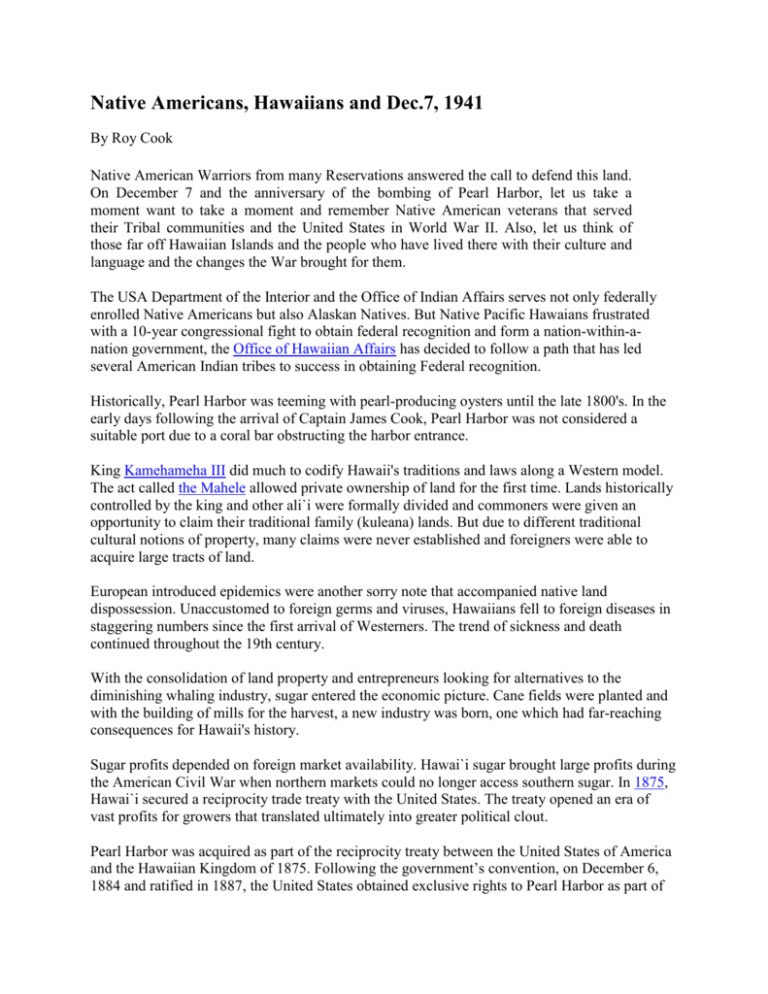
Native Americans, Hawaiians and Dec.7, 1941 By Roy Cook Native American Warriors from many Reservations answered the call to defend this land. On December 7 and the anniversary of the bombing of Pearl Harbor, let us take a moment want to take a moment and remember Native American veterans that served their Tribal communities and the United States in World War II. Also, let us think of those far off Hawaiian Islands and the people who have lived there with their culture and language and the changes the War brought for them. The USA Department of the Interior and the Office of Indian Affairs serves not only federally enrolled Native Americans but also Alaskan Natives. But Native Pacific Hawaians frustrated with a 10-year congressional fight to obtain federal recognition and form a nation-within-anation government, the Office of Hawaiian Affairs has decided to follow a path that has led several American Indian tribes to success in obtaining Federal recognition. Historically, Pearl Harbor was teeming with pearl-producing oysters until the late 1800's. In the early days following the arrival of Captain James Cook, Pearl Harbor was not considered a suitable port due to a coral bar obstructing the harbor entrance. King Kamehameha III did much to codify Hawaii's traditions and laws along a Western model. The act called the Mahele allowed private ownership of land for the first time. Lands historically controlled by the king and other ali`i were formally divided and commoners were given an opportunity to claim their traditional family (kuleana) lands. But due to different traditional cultural notions of property, many claims were never established and foreigners were able to acquire large tracts of land. European introduced epidemics were another sorry note that accompanied native land dispossession. Unaccustomed to foreign germs and viruses, Hawaiians fell to foreign diseases in staggering numbers since the first arrival of Westerners. The trend of sickness and death continued throughout the 19th century. With the consolidation of land property and entrepreneurs looking for alternatives to the diminishing whaling industry, sugar entered the economic picture. Cane fields were planted and with the building of mills for the harvest, a new industry was born, one which had far-reaching consequences for Hawaii's history. Sugar profits depended on foreign market availability. Hawai`i sugar brought large profits during the American Civil War when northern markets could no longer access southern sugar. In 1875, Hawai`i secured a reciprocity trade treaty with the United States. The treaty opened an era of vast profits for growers that translated ultimately into greater political clout. Pearl Harbor was acquired as part of the reciprocity treaty between the United States of America and the Hawaiian Kingdom of 1875. Following the government’s convention, on December 6, 1884 and ratified in 1887, the United States obtained exclusive rights to Pearl Harbor as part of the agreement to allow Hawaiian sugar to enter the United States duty free. Through the 19th century, Hawai`i continued as a fledgling kingdom, maintaining its sovereignty despite designs by the British, Russians, French and Americans to win control of the Islands. Hawaii's monarchs successfully played American and British interests off each other, depending on one then the other for military support. Toward the end of the 19th century, sugar growers and American businessmen in Hawai`i were increasingly disgruntled with the government. They finally took matters into their own hands, bringing about the overthrow of the monarchy. Hawaii's last queen, Lili`uokalani, withdrew from the throne to avoid bloodshed but did not immediately abdicate her title. The usurpers hoped for quick annexation by the United States but had to wait five years. Native American Warriors from many Reservations volunteered to defend this land. And as we consider December 7 and the 2012 anniversary of the bombing of Pearl Harbor, let us take a moment and remember those Hopi veterans that served their village communities and the United States in World War II. Franklin Shupla Charles Lomakema Rex Pooyouma Warren Koiyaquaptewa Percival Navenma Frank Chapella Perry Honani Sr. Travis Yaiva Floyd Dann Sr. Orville Wadsworth One of these individuals was Travis Yaiva (pictured at right) Another was Rex Pooyouma from the village of Hotevilla on Third Mesa. During the War, Mr. Pooyouma served in the Native American Code Talker Communications Network. He was one of at least 10 Hopi code talkers who used their language to transmit critical messages that saved the lives of countless people and helped to end the War. In November 1945, Mr. Pooyouma received an honorable discharge from the Army Air Force with the rank of sergeant. He was a decorated soldier and earned several medals, including the American Campaign Medal, the Philippine Liberation Medal, and a Bronze Star. In October of 2010, Mr. Pooyouma, the last known surviving Hopi code talker, passed away at the age of 93. Navajos formed special all-Navajo Marine Corps signal units that encoded messages in their native tongue. Taking advantage of the flexibility and range of the Navajo language, they worked out translations of military and naval terms so that orders and instructions could be transmitted by voice over the radio in a code the Japanese were never able to break. They were used first in late 1942 on Guadalcanal. Special Code Talker units were eventually assigned to each of the Marine Corps' six Pacific divisions. By war's end, over 400 Navajo had served as Code Talkers. Untold numbers of Marines owe their lives to the Navajo Code Talkers. Additionally, following the Japanese surprise attack on Pearl Harbor, Osage tribesman and Army Col. Clarence Tinker was promoted to brigadier general in 1941. He was promoted to major general in 1942 and was shortly thereafter killed in action while leading a group of LB-30 bombers near Wake Island. Oklahoma's Tinker Air Force Base is named after him. Following the bombing of Pearl Harbor at the Cherokee Qualla Boundary reservation in the Mountains of North Carolina, every eligible young man in the Eastern Band of Cherokee Indians registered for the draft. Eventually, 321 North Carolina Cherokee served in the military, with 123 enlisting and 198 getting drafted. By the war’s end, eleven North Carolina Cherokee had died in action—five in Europe and six in the Pacific—while a twelfth died stateside. Seven more were wounded in action. Besides a number of Purple Hearts, North Carolina Cherokee earned two Distinguished Flying Crosses and two Silver Stars. Also in eastern North Carolina, the Lumbee and other smaller Indian tribes supported the war effort with just as much fervor. Back then, the Lumbee tribe was not officially federally recognized. They passed their own draft act and sent their young braves into National Guard units. Women took over traditional men duties on the reservation. They served in every branch of the service, in every theater of operations. All across Indian America, in spite of years of inefficient and often corrupt bureaucratic management of Indian affairs, Native Americans stood ready to fight the "white man's war." American Indians overcame past disappointment, resentment, and suspicion to respond to their nation's need in World War II. It was a grand show of loyalty on the part of Native Americans and many Indian recruits responded to America's call for soldiers because they understood the need to defend one's own land, and they understood fundamental concepts of fighting for life, liberty, property, and the pursuit of happiness. Also, less we forget, there are 226 of our Native American Military Veterans Vietnam band of brothers on the Vietnam memorial wall. Our Tribal Warriors are still in harm’s way as the numbers of Native Americans who will not be returning home continue to grow from our current involvement in Africa and the Middle East.
